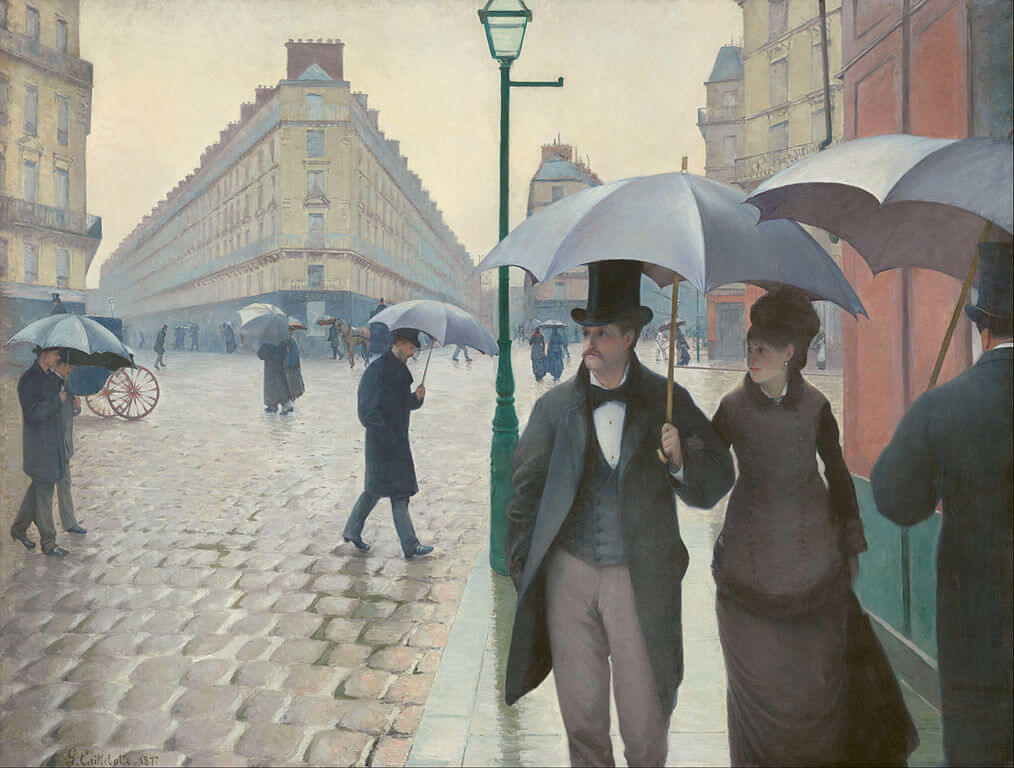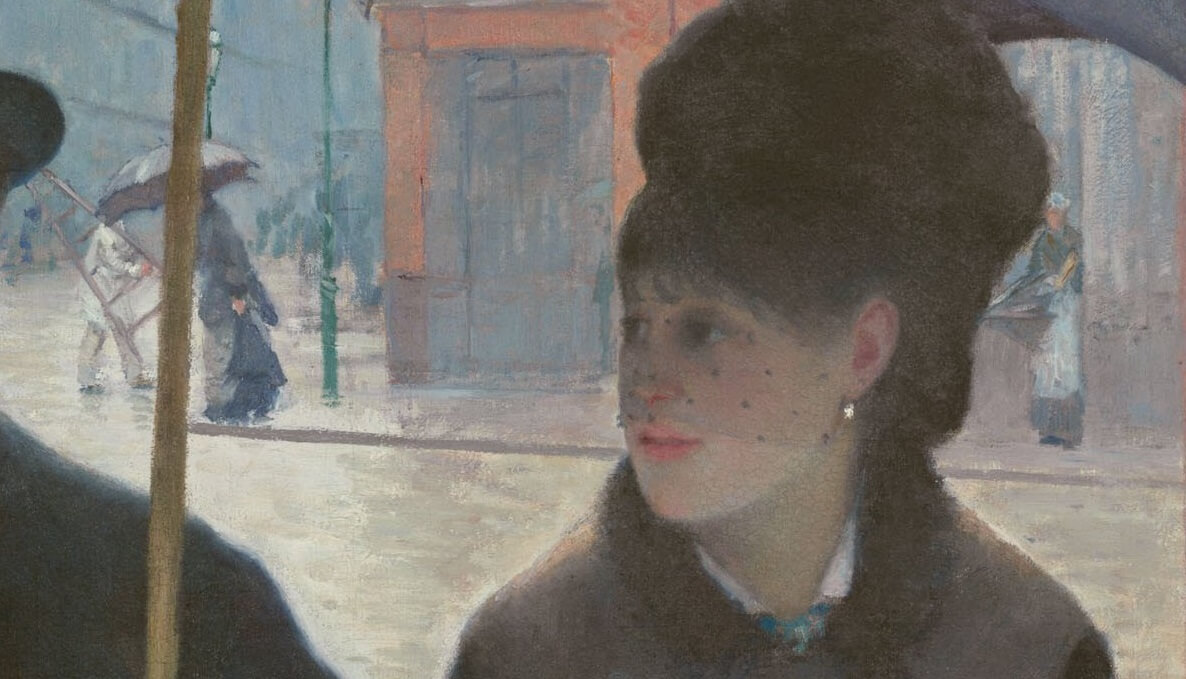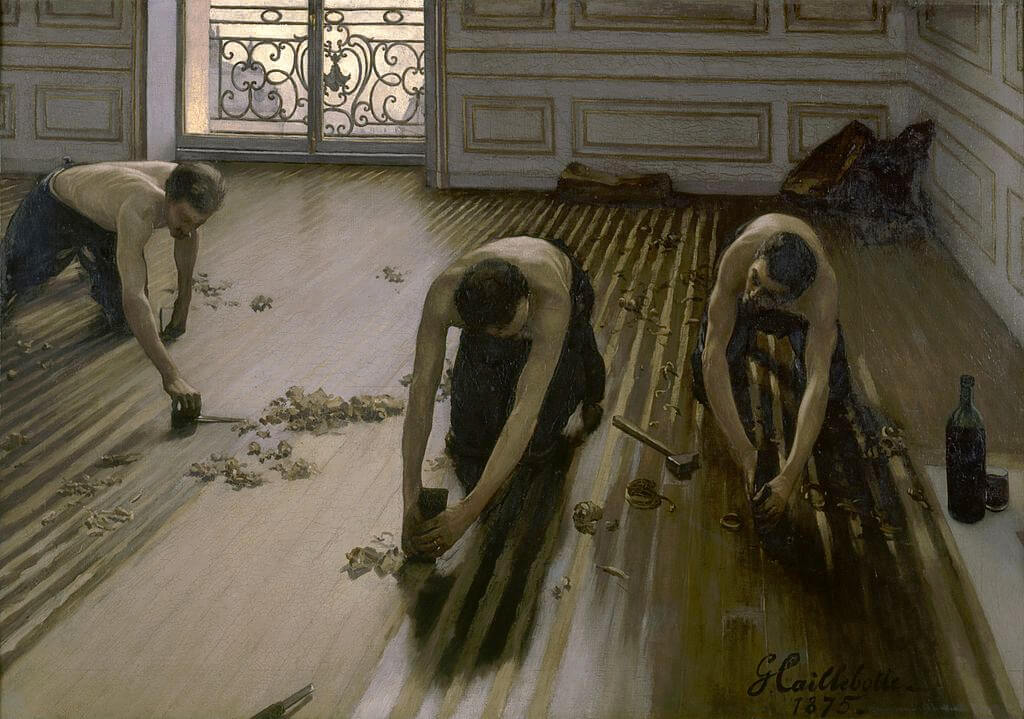|
Where? Gallery 201 at The Art Institute of Chicago
When? 1877 What do you see? A busy, rainy street near the Saint-Lazare station in Paris. The canvas is divided in half by an axis, a tall green streetlamp. Walking on the right of it, in the foreground, are a couple dressed in the latest Parisian fashion. As they walk arm in arm beneath an umbrella, looking off to the left side of the canvas, a stranger passes them with his back to the viewer. Judging by the young woman’s brown dress and diamond earring, the pair are likely of the upper class. The men in the middle ground appear to be dressed in a similar fashion. Further down the canvas are some traces of the working class. Behind the man’s umbrella, a painter dressed in white carries a ladder across the street. Behind the woman, a baker looks out her window. Two carriage drivers can be seen on the left side of the street lamp.
Backstory: Exhibited at the Third Impressionist Exhibition in 1877, Paris Street; Rainy Day was celebrated by many. The natural scene of a real Parisian street painted in a realistic fashion calls back to Caillebotte’s interest in photography. However, the painting’s style cannot be characterized as entirely realist or academic.
Caillebotte features an unusual asymmetrical composition and cropped figures. On the right side of the canvas, the man and woman’s legs are out of frame and the stranger with his back to the viewer is split in half. This detail may be overlooked by modern viewers but was considered radical by Caillebotte’s contemporaries. The cropped composition may have been inspired by his interest in photography. Featuring unsaturated colors and dim light, the painting has a gloomy and slow feeling. Subtly showing the division between the bourgeoisie and the working class, Caillebotte’s palette suits the daunting disparity that is most heavily felt by the workers. Who is Caillebotte? Gustave Caillebotte was born in 1848 in Paris and died in Gennevillers in 1894. He grew up in a wealthy family and began painting in the studio of Leon Bonnat. In 1873, Caillebotte began his studies at the École des Beaux-Arts and shortly after became acquainted with Pierre-Auguste Renoir and Claude Monet. With his money, he was able to support many artists like Edgar Degas, Camille Pissaro, and Alfred Sisley. Although he did not participate in the first one, Caillebotte exhibited eight paintings in the Second Impressionist Exhibition of 1876, one of which was The Floor Scrapers in the Musée d’Orsay. Caillebotte’s academic style combined with an Impressionist influence produced a unique and modern style of art.
Never truly sticking to one style of painting, Caillebotte aimed to depict modern life for what it really was in the realist sense. Nonetheless, an Impressionist influence is evident in his loose brushstrokes and “cropped” paintings.
Fun fact: On the ground floor of the center building in the background, there is a green “pharmacie” sign with yellow letters. Nowadays, the same building, located in between Rue de Moscou and Rue Clapeyron, still has a pharmacy.
Written by Sabrina Tian
References:
0 Comments
Leave a Reply. |
Categories
All
|
- Home
- Blog
-
Museums
- Alte Pinakothek
- Art Institute of Chicago
- Baltimore Museum of Art
- Barber Institute of Fine Arts
- Bargello
- Barnes Foundation
- British Museum
- Church of Sant’Anastasia
- Cleveland Museum of Art
- Courtauld Institute of Art
- Detroit Institute of Arts
- Frans Hals Museum
- Galleria Borghese
- Gallerie dell'Accademia
- Getty Museum
- Guggenheim
- Hermitage Museum
- Kunsthistorisches Museum
- Kunstmuseum Basel
- Legion of Honor Museum
- Louvre
- Mauritshuis
- Metropolitan Museum of Art
- Musee d’Orsay
- Museum of Fine Arts in Boston
- Museum of Modern Art
- National Gallery in London
- National Gallery of Art
- National Museum in Poznań
- Norton Simon Museum
- Ny Carlsberg Glyptotek
- Palace of Versailles
- Palazzo Pitti
- Palazzo Vecchio
- Petit Palais
- Philadelphia Museum of Art
- Prado
- Pushkin Museum
- Ravenna Art Museum
- Rijksmuseum
- San Diego Museum of Art
- Santa Maria delle Grazie
- St. Peter's Basilica
- Städel Museum
- Statens Museum for Kunst
- Tate Britain
- Tate Modern
- Timken Museum of Art
- Uffizi
- Vatican Museums
- Wallace Collection
-
Artists
- Altdorfer
- Anguissola
- Berlin Painter
- Bosch
- Botticelli
- Boucher
- Bronzino
- Bruegel the Elder
- Brunelleschi
- Cabanel
- Caillebotte
- Canova
- Caravaggio
- Carpeaux
- Cezanne
- Cimabue
- David
- Degas
- Delacroix
- De Maria
- Donatello
- El Greco
- Fontana
- Fra Angelico
- Fragonard
- Gauguin
- Gentileschi
- Gericault
- Gonzalez-Torres
- Goya
- Hals
- Hogarth
- Hokusai
- Ingres
- Leonardo da Vinci
- Lippi, Filippo
- Longhi, Barbara
- Lorrain
- Makovsky
- Manet
- Massys
- Matisse
- Merian
- Michelangelo
- Mochi
- Modigliani
- Monet
- Panini
- Parmigianino
- Perugino
- Picasso
- Pisanello
- Raphael
- Rembrandt
- Renoir
- Reynolds
- Rivera
- Rodin
- Rubens
- Scultori
- Seurat
- Steen
- Tintoretto
- Titian
- Toulouse-Lautrec
- Turner
- Uccello
- Van der Weyden
- Van Dyck
- Van Eyck
- Van Gogh
- Van Hemessen
- Vasari
- Velazquez
- Vermeer
- Veronese
- Vigée Le Brun
-
Locations
- Books
- About Us



